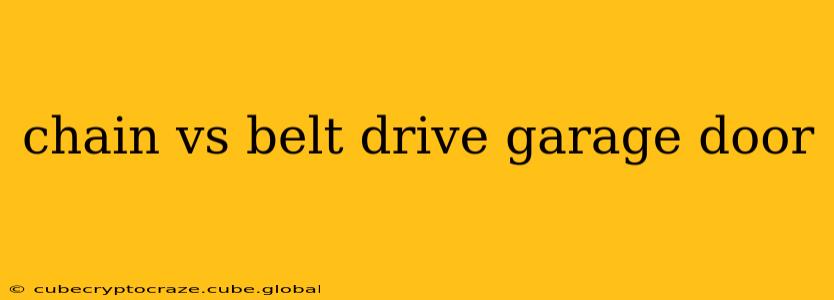Choosing a new garage door opener can feel overwhelming. One of the first decisions you'll face is whether to opt for a chain drive or a belt drive system. Both accomplish the same task – opening and closing your garage door – but they do so with different mechanisms and offer distinct advantages and disadvantages. This comprehensive guide will help you understand the key differences to make the best choice for your home.
What is a Chain Drive Garage Door Opener?
Chain drive openers are the most common and typically the most affordable option. These systems use a metal chain to connect the motor to the garage door trolley. The chain moves up and down, pulling the door open and closed.
Advantages of Chain Drive Openers:
- Cost-effective: Generally less expensive than belt drive systems.
- Durable and reliable: Chain drive mechanisms are robust and can withstand heavy use.
- Easy to repair: Parts are readily available and repairs are often simpler and cheaper.
Disadvantages of Chain Drive Openers:
- Noisy operation: The metal chain creates a noticeable and often loud clicking or clanking sound during operation. This can be disruptive, especially in homes with attached garages.
- Increased vibration: The chain mechanism can cause vibrations that may be felt throughout the garage.
- Potential for damage: The chain can potentially damage the garage door track or even the door itself over time if not properly maintained.
What is a Belt Drive Garage Door Opener?
Belt drive openers utilize a reinforced rubber belt instead of a chain. This belt connects the motor to the trolley, offering a quieter and smoother operation.
Advantages of Belt Drive Openers:
- Quieter operation: The rubber belt produces significantly less noise than a chain, making it a preferable option for those seeking a quieter garage.
- Smoother operation: The belt drive mechanism provides a smoother, more refined movement, reducing vibrations and wear and tear on the door and track.
- Longer lifespan: The belt is less prone to wear and tear than a chain, potentially extending the lifespan of the opener.
Disadvantages of Belt Drive Openers:
- Higher cost: Belt drive openers are generally more expensive than chain drive models.
- Potential for belt slippage: While less common, a worn or damaged belt can slip, potentially leading to malfunction.
- Less durable: Although they generally last longer, a belt can be more susceptible to damage from extreme temperatures or other environmental factors compared to a chain.
Which is Better: Chain Drive or Belt Drive?
The "better" option depends entirely on your individual priorities and needs.
- Prioritize budget and durability? A chain drive opener is likely the best choice.
- Prioritize quiet operation and smoothness? A belt drive opener is the clear winner.
- Living in a climate with extreme temperatures? Consider the potential impact on both chain and belt systems and choose accordingly.
How Much Does a Garage Door Opener Cost?
The cost varies considerably depending on the type of opener (chain or belt), features (battery backup, smart home integration), and brand. Expect to pay anywhere from a few hundred dollars to over a thousand dollars for a new garage door opener.
How Long Do Garage Door Openers Last?
The lifespan of a garage door opener depends on several factors, including usage, maintenance, and the quality of the unit. Generally, you can expect a well-maintained opener to last anywhere from 10 to 15 years.
What are the Different Types of Garage Door Openers?
Aside from chain and belt drive, there are also screw drive and direct drive openers. Screw drive openers use a threaded rod, while direct drive openers connect the motor directly to the door. These are less common than chain and belt drive options.
By carefully considering these factors and weighing your priorities, you can confidently choose the garage door opener that best suits your needs and budget. Remember to factor in noise levels, budget, and long-term maintenance when making your decision.
